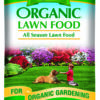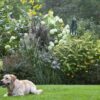Key Takeaways
- Many drought-tolerant plants are also safe for dogs, offering a practical solution for pet-friendly landscaping.
- Lavender, thyme, and sage are some herbs that are both drought-resistant and non-toxic to dogs.
- Non-toxic flowering plants like snapdragons and zinnias provide color without the risk to your pets.
- Succulents and ornamental grasses can add texture to your garden and are generally safe for dogs.
- It’s important to avoid plants known to be toxic to dogs, such as sago palms and oleander.

“Blue oat grass is commonly dom… | Flickr” from www.flickr.com and used with no modifications.
Creating a Safe and Inviting Garden for Your Furry Friends
Imagine stepping outside into your garden, feeling the warmth of the sun, and seeing your dog happily exploring amidst the greenery. It’s a serene picture, but one that requires a bit of planning to ensure your pet’s safety and the sustainability of your garden. With the right plants that are both drought-tolerant and safe for dogs, you can create an outdoor space that thrives in arid conditions and keeps your pet healthy and happy.
Safe Havens: Dog-Friendly Plants for Arid Climates
Whether you live in an area that experiences frequent droughts or you’re just looking to conserve water, choosing dog-safe, drought-tolerant plants is a wise decision. These plants not only require less maintenance and water but also ensure that your pets are not at risk of poisoning from toxic plants.
Keeping Tail Wags in Your Garden
When selecting plants for your garden, consider their safety for your dog. This means steering clear of plants like oleander, sago palm, and azaleas, which are toxic to dogs. Instead, focus on plants that can withstand dry conditions and pose no threat to your pet.
The Secret to a Pet-Safe Green Space
The secret lies in choosing plants that are both resilient in the face of drought and non-toxic to dogs. This dual focus ensures that your garden is both environmentally friendly and safe for all members of your family, including the four-legged ones.
Top Picks for Your Pooch-Proof Plant Paradise
When it comes to creating a pooch-proof plant paradise, there are a variety of options that will keep your garden looking lush without worrying about your dog’s health.
Flowering Favorites: Non-Toxic and Low-Water
Some flowering plants can offer the best of both worlds—bright, beautiful blooms and a safe environment for your pet. Here are a few non-toxic options:
- Snapdragons (Antirrhinum majus)
- Zinnias (Zinnia spp.)
- Marigolds (Tagetes spp.)
- Sunflowers (Helianthus annuus)
These flowers not only add a splash of color to your garden but also require minimal watering, making them ideal for drought-prone areas.
Herbs that Make Scents for Canines
Herbs are not just for cooking; they can also be a fragrant and practical addition to your dog-friendly garden. Consider these dog-safe, drought-tolerant herbs:
- Lavender (Lavandula spp.) – Known for its calming properties and ability to repel fleas.
- Thyme (Thymus vulgaris) – Requires little water and is a hardy ground cover.
- Sage (Salvia officinalis) – Aromatic and can tolerate dry soil.
These herbs are easy to grow and maintain, making them a hassle-free choice for busy gardeners.
Blooms Without Doom: Pretty and Pet-Friendly
Flowers can transform a garden from plain to picturesque. Opt for pet-friendly varieties like:
- African Daisy (Osteospermum) – Offers a burst of color and is non-toxic to dogs.
- Coreopsis (Coreopsis spp.) – Bright, cheerful flowers that are safe for pets.
These blooms provide visual interest and peace of mind, knowing they won’t harm your furry friend.
Hardy Succulents for Hardy Pups
For pet owners in dry climates, succulents are a godsend. These sturdy plants need little water and are generally non-toxic to dogs. Aloe vera, often thought to be a safe plant, is actually harmful to pets, so steer clear of it. Instead, choose from these dog-friendly succulents:
- Hens-and-chicks (Sempervivum tectorum)
- Burro’s tail (Sedum morganianum)
- Haworthia (Haworthia spp.)
These succulents not only withstand drought but also add a touch of architectural beauty to your garden without endangering your pup.
Lush Grass Choices That Won’t Leave You in the Dust
Grasses can offer a soft, comfortable surface for dogs to play on, and there are several drought-tolerant varieties that are also safe for dogs. Buffalo grass (Bouteloua dactyloides) and Bermuda grass (Cynodon dactylon) are two such options. They require minimal watering once established and provide a durable playing surface for your furry friends.
Designing Your Drought-Resistant Dog Haven
Designing a garden that’s both drought-resistant and dog-friendly involves more than just plant selection. It’s about creating a space that your pets can enjoy without harming themselves or your garden. This means considering the layout of your plants, the type of mulch you use, and even the materials for your walkways.
When designing your space, keep in mind the following:
- Choose plants that are sturdy enough to withstand a little roughhousing from your pets.
- Use mulches that are soft on paws yet won’t become a digging delight for curious dogs.
- Designate a specific area for your dog to relieve itself to prevent lawn burn.
Strategic Plant Placement for Pups
Place more delicate plants in areas that are less accessible to your dog. Raised beds or fenced-off sections can protect your plants while still allowing your pet to roam freely in designated zones. Consider using sturdy shrubs or small trees as natural barriers to direct your dog’s path away from sensitive areas.
Spatial Planning: Paths and Boundaries
Creating clear paths and boundaries not only adds structure to your garden but also helps your dog understand where it can and cannot go. Use materials like flagstone or decomposed granite for paths, as they are gentle on paws and discourage digging.
The Green Thumbs-Up: Ensuring Plant Safety for Dogs
As you choose plants for your garden, it’s crucial to ensure they are safe for your dog. While many plants are non-toxic, others can pose serious health risks to your pets. Be vigilant and do your research to create a garden that’s safe for all family members.
Common Toxic Plants to Avoid
Avoid plants that are known to be toxic to dogs. Some of the most common culprits include:
- Oleander (Nerium oleander)
- Sago Palm (Cycas revoluta)
- Azalea (Rhododendron spp.)
- Castor Bean (Ricinus communis)
These plants can cause a range of symptoms from mild gastrointestinal upset to more severe reactions, including death. For creating a balanced and pet friendly landscape with safe plants, consider researching alternatives that are non-toxic to pets.
Naturally Pet-Friendly Fertilizers and Pest-Control
To maintain a healthy garden that’s safe for pets, opt for natural fertilizers and pest control methods. Compost and well-rotted manure are excellent choices for enriching your soil without the use of chemicals. For pest control, consider beneficial insects like ladybugs or natural repellents such as neem oil.
A Closer Look at Drought-Tolerant Breed Compatibility
Not all dogs interact with their environment in the same way. Some breeds have a higher prey drive and may be more inclined to dig or chase, potentially damaging more delicate plants. Other breeds may be content with lounging in the shade or simply strolling through the garden.
The Great Outdoors: Plants for Active vs. Lazy Pups
For active dogs, consider plants that can withstand a bit of trampling, such as clover (Trifolium spp.) or silver carpet (Dymondia margaretae). For less active breeds, you might opt for plants that require less robustness, like the beautiful blue fescue (Festuca glauca).
Small Space, Big Impact: Balcony-Friendly Varieties
Even if you don’t have a large garden, you can still create a dog-friendly green space on your balcony or patio. Choose pots of lavender or dwarf zinnias, which can tolerate dry conditions and won’t harm your pet if ingested.
A Pet’s Garden is Their Kingdom: Final Considerations
As we wrap up our exploration of dog-safe drought-tolerant plants, remember that the comfort and safety of your pets are as important as the health of your garden. With thoughtful planning and the right plant choices, you can create a harmonious outdoor space that caters to the needs of your four-legged family members.
It’s also vital to remember that while we focus on drought tolerance and pet safety, the overall design and layout of your garden will play a significant role in its success. Ensure there’s shade for your pets to cool off, and always provide fresh water to keep them hydrated, especially in hot climates.
Dealing With Digging: Durable Ground Covers
Dogs love to dig, and it’s a natural behavior you can’t always prevent. However, you can choose ground covers that are tough enough to withstand a dog’s curiosity. Here are some options:
- Clover (Trifolium spp.) – Soft to walk on and resilient to foot traffic.
- Silver carpet (Dymondia margaretae) – Tolerates dry conditions and is hardy under paws.
- Creeping thyme (Thymus serpyllum) – Releases a pleasant scent when trodden upon and is edible.
These ground covers can take a beating and bounce back, ensuring your garden stays intact even when your dog gets the zoomies.
Most importantly, when choosing ground covers, look for those that spread quickly to cover bare spots and that don’t mind a little rough play. This will keep your garden looking lush and green, despite your dog’s best efforts to create a personal playground.
Watering Wisdom: Keeping Plants Thriving While Conserving
Conserving water doesn’t mean neglecting your plants’ needs. It’s about smart watering practices that maximize efficiency. Water early in the morning or late in the evening to reduce evaporation. Drip irrigation systems can target the root zones directly, minimizing waste. And always adjust your watering schedule based on rainfall to avoid overwatering.
Frequently Asked Questions
Got more questions? You’re not alone. Here are some common queries from fellow pet-loving gardeners:
Are All Cacti Safe for Dogs?
Not all cacti are safe for dogs. While most cacti aren’t toxic, their spines can cause injuries. If you have a curious pup, it’s best to keep cacti out of reach or opt for spineless varieties.
Can I Train My Dog to Avoid Certain Areas?
Yes, with patience and consistent training, you can teach your dog to avoid certain areas of the garden. Use barriers, like small fences, and train with positive reinforcement to establish clear boundaries.
How Often Should Drought-Resistant Plants Be Watered?
Drought-resistant plants typically need less frequent watering, but it’s not a one-size-fits-all schedule. Monitor the soil moisture and water when the top inch feels dry. Over time, you’ll learn the rhythm that keeps your plants thriving.
What Are The Signs My Dog Is Allergic to a Plant?
If your dog is allergic to a plant, you might notice symptoms like itching, redness, or swelling of the skin. In some cases, there may be sneezing, coughing, or other respiratory signs. If you suspect an allergy, consult your vet.
Can Drought-Tolerant Plants Withstand Dog’s Urine?
Some drought-tolerant plants are more resilient to dog urine than others. Grasses like Bermuda and Buffalo grass can usually handle the occasional accident. However, it’s good practice to rinse the area with water to dilute the urine and prevent burn spots.
Remember, creating a dog-friendly garden is a rewarding journey. With the right plants and a little know-how, you can enjoy a beautiful, thriving garden that your pets can enjoy safely. Happy gardening!
Lovie’s Pet Safe Plant Picks
Lovie loves having a pet safe sensory sanctuary filled with flora he can sniff, chew, and rub against without threat of harm. Kamala created a list of plants, especially flowering plants that grow well in containers, most of which are drought tolerant perennials, and many repel pets.
Check out Kamala & Lovie’s growing list of Pet Safe Plants.





